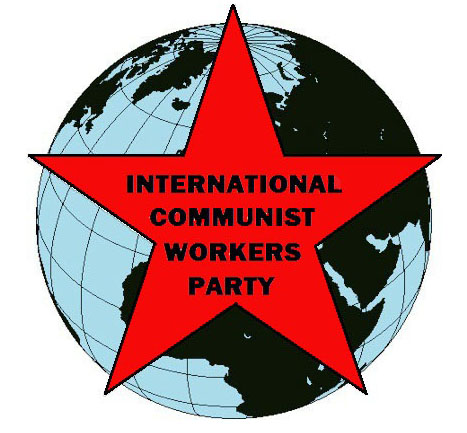
 |
FIGHT FOR COMMUNISM! |
International Communist Workers Party | |

Almost a century ago (Nov 7, 1917) the Bolshevik party seized power in Russia. John Reed, who helped found the US Communist Party, wrote a famous eye-witness account entitled Ten Days that Shook the World. In the end the Bolsheviks failed to establish communism, but the capitalist world is still shaking from the attempt.
We in the International Communist Workers’ Party are proud to be heirs of the Bolsheviks. We have learned a lot from both their successes and their failures.
The Bolsheviks, like the ICWP, started out small. They were originally members of the Russian Social Democratic Labor Party (RSDLP). The RSDLP began in study groups of Marxist intellectuals. These groups were scattered and inexperienced but they did two things right: they reached out to the working class and they formed a party with a newspaper Iskra (meaning “spark”).
The RSDLP represented a mixture of ideas. Lenin was on the left. His comrades wanted a proletarian revolution, the dictatorship (undisputed rule) of the working class, and (eventually…) communism.
On the right was Martov, whose followers wanted to help the capitalists overthrow the Czar. They envisioned a long period of capitalism followed, at some time in the distant future, by some kind of “socialism.”
These views were incompatible, and the RSDLP split in 1903.
The split itself was about three things: the very nature of the party; whether to limit the struggle to fighting for economic reforms or struggle to overthrow capitalism; and the need for one nationwide communist newspaper. Both sides agreed that communism could not be implemented right away.
Martov wanted a very loose organization where anybody who considered him- or herself a member of the party, was. There was no expectation that these ‘members’ would actually work to build the party if they didn’t feel like it. They were called the Mensheviks.
Lenin, on the other hand, wanted members to be committed to carrying out decisions made collectively (this was called “democratic centralism”). This is the way the ICWP operates. When we decide to do something (after much collective discussion) members carry out these decisions. Even if they don’t feel like it. And even if they don’t agree with it. This group was called the Bolsheviks. They believed in a cadre party.
But building a communist world requires a mass party with millions of communist leaders who have different levels of commitment and understanding of what is needed to make a revolution and are open to struggle. We in ICWP believe in communist centralism: masses will fight for communism to the extent they believe in it.
Shortly after the split, the 1905 revolution broke out (after the Czar’s navy got its butt kicked by the Japanese navy). The 1905 revolution was soon suppressed, but the Bolshevik organizational principles were vindicated. The Mensheviks basically dissolved but the Bolsheviks survived the repression and soon revived.
In 1914 there was a wave of strikes and demonstrations in Petrograd, led mainly by the Bolsheviks. However, the Czar entered World War I on the side of Britain and France (who basically owned Russia). The (brief) wave of patriotic enthusiasm wrecked the workers’ movement and millions were sent to the trenches.
The war went badly for the Russians, thanks to incompetent leadership, corruption and economic backwardness. Soon both the military and civilians were going hungry. Soldiers were sent to the front without arms. Nearly two million were killed, more than five million wounded.
Workers, soldiers and sailors had enough. In February of 1917, the Czar was overthrown in a revolution sparked by an International Women’s Day demonstration. The monarchy was replaced by the Provisional Government led by the socialist Kerensky. Kerensky, backed by the Mensheviks, stayed in the war and even launched a disastrous offensive. By October 1917 workers, soldiers and sailors had once again had enough.
The Bolsheviks, realizing the time was ripe, set to work planning the insurrection. They’d already trained a Red Guard (workers’ militia) and had thousands of soldiers and sailors ready to move. In Petrograd and some cities, they easily overwhelmed the opposition. In others, it was a harder fight. In Moscow it took six days of street fighting and over 1000 dead on the side of the revolutionaries.
Next basically everyone outside the working class and peasantry ganged up on the Bolsheviks. Mensheviks, most professionals, ‘liberal’ capitalists, monarchists and the 14 imperialist powers merged into a force called the “Whites.” They waged a bitter three-year civil war which caused millions of deaths. But the Bolsheviks mobilized the masses, built a huge army which used revolutionary new tactics, and smashed the Whites.
So what went wrong? Why is Russia now an openly capitalist, imperialist state?
The source of the problem goes back to the issues behind the original split. It turned out that Lenin and most of the Bolshevik leaders also believed Russia needed a good dose of capitalism. The actual difference was that they believed it should be managed by communists, not by the old bosses.
As soon as the civil war was over they introduced the New Economic Policy (NEP), which brought back money, the wage system, markets and production for profit. Over time, it also brought back crises of overproduction and unemployment.
Communists were put in the position of acting like capitalists. Over the years, they became what they were pretending to be. There was a lot of opposition to the NEP, and it took a while till the rot reached the top, but the end result was capitalism, not communism.
The ICWP will not make the same mistake. We will institute communism as soon as we take power, even before the inevitable civil war. No money, no wages, no market, no unemployment.
We start now mobilizing the masses for communism; we continue after the revolution. Together we will finish what the Bolsheviks started nearly a hundred years ago.